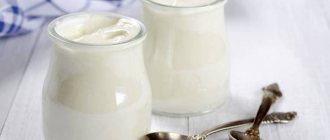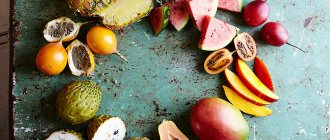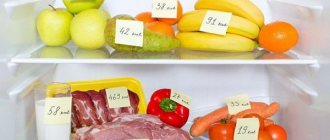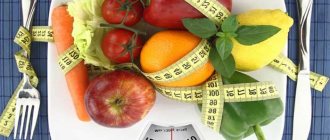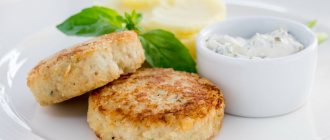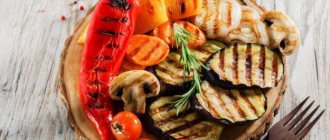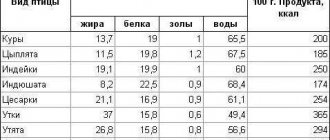If you use fruits wisely (eat them half an hour before lunch or 2-4 hours after it), you can get health and figure benefits: most fruits are low-calorie.
List of the lowest calorie fruits for weight loss
Nutritionists strongly recommend including fruits and berries in your diet. They increase vitality, saturate the body with vitamins, and improve metabolism. Even if you replace one meal with a serving of fruit, you can reduce your daily caloric intake, which will promote weight loss.
Fruits contain fiber and structured water. Fiber removes toxins from the body, normalizes the gastrointestinal tract, stimulates intestinal motility, normalizes cholesterol levels and prevents blood glucose from rising sharply.
Structured water normalizes the body's acid-base balance, improves metabolism and removes toxins. It contains vitamins and microelements necessary for the passage of important physiological processes, maintaining the health and beauty of the body.
Eating fruit while losing weight is not only possible, but even necessary. The main thing is to choose the right fruits for your diet and control the amount of fruits eaten. If your goal is to lose weight, it is advisable to eat low-calorie fruits with a low glycemic index. Nutritionists recommend giving preference to those fruits that contain no more than 100 kcal per 100 g, and ideally up to 50 kcal.
You can understand how dangerous a fruit is for your figure, even without knowing the exact value of its calorie content, by its taste. The sweeter the fruit, the higher the calorie content it is. And vice versa, the more sour the fruit, the fewer calories it contains. The most high-calorie foods are grapes, persimmons, and dried fruits. The fewest calories are in apples, kiwis, and citrus fruits. Below is a list of 10 fruit “favorites” of nutritionists.
10th place – bananas
Although bananas are not the lowest-calorie fruit, and they contain natural sugars and starch, even when losing weight, nutritionists do not prohibit their consumption, with one caveat - in small quantities.
The calorie content of bananas depends on their degree of ripeness. Soft yellow fruits contain about 95 kcal per 100 g, and dense, unripe fruits contain about 70 kcal. Therefore, when losing weight, it is better to choose greenish bananas that contain less sugar.
Although the calorie content of bananas is higher than that of apples, pears, apricots or plums, their pulp perfectly satisfies hunger. It does not irritate the gastric mucosa because it contains a minimal amount of organic acids.
9th place - apples
According to Nutrition magazine, eating an apple before your main meal speeds up your metabolism, which is beneficial for weight loss. Just 5 apples are enough to provide the body with the daily requirement of fiber. Of course, it is better to eat more than just apples, but to make the menu more varied.
Apples, depending on the variety, contain from 35 to 55 kcal per 100 g of pulp. The lowest-calorie varieties with a sour taste and green skin: Golden, Granny Smith, Papirovka, Antonovka. Red apples have a higher calorie content. The sweetest varieties are considered to be: Red Delicious, Gala, Starking.
Important! Apples themselves are low-calorie and healthy, but only fresh. When adding them to a pie, baking with honey and nuts, the calorie content of the fruit increases significantly.
8th place – pears
Pears are rich in coarse dietary fiber - fiber that improves the functioning of the gastrointestinal tract, helps remove harmful substances from the body, and creates a feeling of satiety. This fruit is often included in the diet when losing weight due to its low calorie content. 100 g of pear contains about 44 kcal, and one medium-sized fruit contains about 70 kcal.
Pear improves a person’s emotional state when losing weight. It contains magnesium, which has a beneficial effect on the nervous system and helps the body cope with stressful situations more easily.
When losing weight, pears should be eaten with the skin on. It is not advisable to cut it off, since it contains valuable dietary fiber. It is best to include pears in your diet as a dessert, 30 to 50 minutes after the main meal. It is better not to eat them on an empty stomach, as fiber can cause discomfort in the stomach, and organic acids can increase the feeling of hunger and lead to overeating.
7th place – watermelon
Although watermelon is a berry, we are used to classifying it as a fruit. Watermelon consists of 90% water, so it is often used in the preparation of dietary rations.
100 g of watermelon pulp contains about 30 kcal. When consumed, the kidneys are cleansed, the body’s water balance is normalized, and swelling is reduced. It is especially useful for those who cannot train themselves to drink 2 liters of water a day. Watermelon contains the amino acid arginine, which promotes fat burning.
However, watermelon contains a lot of sugars - easily digestible glucose and fructose, and you can eat a lot of it without noticing it. It is important to control the amount of product eaten and not overuse it. As for popular watermelon diets, nutritionists warn about their dangers: they are unbalanced, create a high load on the kidneys, and can cause indigestion, flatulence, and abdominal pain. Unloading on watermelons can be carried out for no longer than 1 – 2 days and in the absence of contraindications. At the same time, you should not eat more than 2 kg of watermelon pulp during the day.
6th place – grapefruit
Grapefruit is famous for speeding up the fat burning process. It contains bioflavonoids that activate the process of weight loss. Eating grapefruit improves digestion and speeds up metabolism.
In addition, citrus fruits are low-calorie fruits; they can be the best choice for weight loss. 100 g of grapefruit pulp contains about 42 kcal. By eating half a grapefruit half an hour before meals, you can quickly feel full, which means reducing the portion size of the main dish.
However, it is important to remember that not everyone can eat grapefruit. For ulcers, gastritis, and increased stomach acidity, citrus fruits are contraindicated. It is especially dangerous to consume them on an empty stomach.
5th place – kiwi
Kiwi is a low-calorie fruit. 100 g contains about 60 kcal. One medium-sized fruit is only 70 - 80 kcal. But how much benefit!
A medium-sized kiwi fruit contains the daily dose of vitamin C for an adult. Kiwi contains potassium, phosphorus, magnesium, calcium, iodine, and zinc. They ensure healthy skin, hair, nails, bones, increase the tone and immunity of the body.
Kiwi contains many organic acids. They stimulate the secretion of gastric juice, improve the digestion of food, prevent its stagnation in the gastrointestinal tract, and remove waste and toxins from the body. Another advantage is that kiwi dulls the feeling of hunger and discourages cravings for sweets.
4th place – plum
Plum is a low-calorie fruit that has a cleansing effect on the body. Both of these properties have a beneficial effect on the process of losing weight. Fruit acids and fiber in plums normalize the digestion process and improve intestinal function. The calorie content of fresh plums is about 45 kcal per 100 g. In order not to slow down the weight loss process, you should limit yourself to 150 - 200 grams of plums per day.
Dried plums - prunes - are a higher calorie product, although no less beneficial for the body. During the period of weight loss, prunes can also be included in the diet, but in small quantities - up to 50 g per day. The calorie content of prunes is 250 kcal per 100 g. Dried plums have a laxative effect. Constipation often occurs when following high-protein diets. Eating prunes in the evening and drinking enough water throughout the day will help eliminate this problem.
3rd place – apricot
Apricots can be good aids in losing weight. 100 g of fruit contains about 40 kcal, and one medium-sized fruit contains about 18 kcal. One fruit contains about 3 g of carbohydrates and 1 g of fiber.
When losing weight, apricots can be added to porridge, cottage cheese, yogurt, cottage cheese casseroles, replacing sugar with them. Dishes with apricots are aromatic, nutritious and more dietary than those with sugar.
The vitamin and mineral composition of apricot helps speed up metabolism. Eating apricots is useful for people with obesity and slow metabolism. It is enough to eat 2–3 fruits a day so that the body receives the nutrients it needs and excess carbohydrates are not stored as fat.
2nd place – oranges
Orange is the lowest calorie fruit and is ideal for weight loss. 100 g of orange pulp contains only 36 kcal, 8 g of carbohydrates, 0.9 g of protein and 0.2 g of fat. An equally important indicator for those losing weight is the glycemic index of orange. It is low, about 43 units. These numbers indicate that orange is an excellent product for losing weight.
There are even orange mono-diets, which involve eating only oranges for several days. But such diets are unbalanced and can cause more harm to the body than good. It is especially dangerous to follow them for people with digestive problems, high acidity, ulcers and gastritis.
1st place – pineapple
The calorie content of pineapple is slightly higher than other fruits in our rating, but its benefits for weight loss are much greater. Pineapple has become famous as a fat burner product. Its pulp contains the enzyme bromelain, which speeds up metabolism and improves fat and protein metabolism.
100 g of pineapple pulp contains only 48 kcal. A serving of pineapple (150 - 200 g) will not harm your figure and will even speed up the process of losing weight.
However, it is important to understand that simply adding pineapple to your daily menu is not enough to lose weight. Moreover, if a portion of fruit becomes an “add-on” to the main diet, the weight may “creep” up. Pineapple should be used to replace sweets, if they were present in the diet, or other carbohydrate-containing foods, maintaining the balance of BJU. Only by creating a calorie deficit in your diet can you start the process of losing weight.
Cereals
Cereals have never been considered low-calorie, but many diets are based specifically on cereals. Why? The fact is that only dry cereals are high in calories. When cooked, their calorie content is noticeably reduced.
- Wheat porridge in viscous form - 90 kcal/100 g. Contains vitamins E, C, A, group B, PP. It is also rich in useful microelements: calcium, iron, phosphorus and others. Eliminates problems with the gastrointestinal tract, strengthens the immune system.
- Friable rice - 113 kcal/100 g. Removes toxins and waste from the body, improves digestion. Contains antioxidants, as well as useful microelements: iodine, zinc, phosphorus, calcium, B vitamins.
- Viscous oatmeal - 88 kcal/100 g. An excellent source of fiber, as well as microelements: iodine, zinc, calcium, magnesium and others. It has a beneficial effect on the development of muscle and bone tissue and improves metabolism.
TOP 5 lowest calorie berries you can eat on a diet
Berries contain a whole range of vitamins and microelements that improve overall health and metabolism. They contain bioflavonoids and antioxidants, which accelerate fat burning, as well as fiber and organic acids, which improve digestion and eliminate harmful substances from the body. So regularly eating berries is an effective way to speed up the weight loss process. But not all berries are suitable for the diet of those losing weight. It is important to choose low-calorie, low-sugar fruits. Our TOP includes the 5 best berries for weight loss.
5th place: cranberry
Cranberries improve digestion by stimulating the production of gastric juice. It stimulates intestinal motility and accelerates its cleansing. Cranberry is a powerful antioxidant. It removes waste and toxins, strengthens the immune system, and suppresses the proliferation of pathogenic flora in the body.
Cranberries are low in calories. 100 g of berries contain 45 kcal. Berries are 88% water. Product BJU:
- proteins – 0.4 g;
- fats – 0.1 g;
- carbohydrates – 12.2 g.
To speed up the weight loss process, you can drink a glass of cranberry juice daily, diluted with water in a ratio of 1:5. To improve the taste of the drink, you can add half a teaspoon of honey.
1 – 2 times a week you can arrange fasting days on cranberries. To make it more comfortable to follow a diet, you can eat a portion of oatmeal with water for breakfast, and during the day drink cranberry juice, diluted cranberry juice and eat fresh berries. In a day, you can lose up to 2 kg on cranberries, activate your metabolism, and normalize your appetite. Such unloading is contraindicated for gastrointestinal diseases and increased stomach acidity.
4th place: raspberry
Fresh raspberries can replace a sweet dessert. It is aromatic and has a pleasant rich taste, but unlike sugar-containing desserts, a glass of raspberries contains less than 100 calories. The energy value of 100 g of berries is 46 kcal. BJU:
- proteins – 0.8 g;
- fats – 0.5 g;
- carbohydrates – 8.3 g.
Berries contain about 83% water. Raspberries are rich in dietary fiber. 100 g of fruit contains almost 3.8 g of fiber. When eating raspberries, discomfort from the gastrointestinal tract rarely occurs. It is easily digested without creating heaviness in the stomach. The glycemic index of raspberries is lower than that of other berries, due to which, when consumed, there is practically no increase in blood sugar, which means satiety lasts longer. Raspberries have a mild diuretic effect, which allows you to remove excess fluid from the body and eliminate tissue swelling.
Raspberries make a delicious snack on their own, but they can also be added to a variety of dishes. Nutritionists recommend including raspberries in your daily menu.
3rd place: strawberry
Strawberries are a juicy and sweet berry that contains a minimum of calories. 100 g of strawberries contain only 41 kcal. The berry contains about 87% water. Product BJU:
- proteins – 0.8 g;
- fats – 0.3 g;
- carbohydrates – 7.7 g.
During the berry season, you can easily lose a couple of extra pounds by simply replacing your usual sweets with fragrant strawberries. You can use it to prepare low-calorie desserts: strawberry mousses, jelly, sorbet. Strawberries can be a tasty addition to cottage cheese, porridge, and yogurt.
2nd place: blueberries
The low calorie content of blueberries makes them a good assistant for weight loss. On a diet, many experience an increased feeling of hunger, especially if the diet has been sharply reduced. Snacking on blueberries will help satisfy your hunger without harming your figure. 100 g of berries contain only 37 kcal. A glass of blueberries can be a substitute for dessert, a light afternoon snack, or a second dinner before bed. A couple of tablespoons of blueberries thrown into porridge or cottage cheese will turn a boring diet dish into a delicious treat.
1st place: black currant
Restrictions in food products during a diet can provoke hypovitaminosis. A lack of vitamins leads to loss of strength, sleep problems, deterioration in the appearance of skin, hair and nails, and mood swings. Black currants, which are also one of the least high-calorie berries, can prevent the problem.
This berry contains high doses of vitamins and minerals, organic acids and bioflavonoids. At the same time, its calorie content is very low - about 40 kcal per 100 g. The glycemic index of black currant is 15 units. This makes currants an ideal product for losing weight. When consumed, carbohydrates are slowly absorbed by the body, without causing a jump in glucose levels and providing long-term satiety.
Note: you can also include red and white currants in your weight loss menu. They have similar caloric content, but they contain less nutrients.
What fruit fasting days will help you lose weight quickly?
Doctors advise absolutely everyone, regardless of whether you are on a diet or not, to give yourself at least one fasting day a week.
Do you know why? The body needs rest!
And if you are also trying to lose excess weight, then for you this is the main rule that you must strictly follow.
EXPERT OPINION : The effectiveness of any diet can only be increased by fasting days!
They are:
- improve the functioning of the gastrointestinal tract;
- accelerate metabolic processes in the body;
- remove excess fluid, preventing swelling;
- have a beneficial effect on kidney function;
- will help you lose up to 1.5 kg of excess weight per day;
- and most importantly, they help overcome the unpleasant “plateau” period in weight loss.
Choose a diet for a fasting day based on your goals and preferences. Look for the most effective option for yourself!
Kefir-apple fasting day
You will need green apples and 1% kefir. This kind of unloading is a very good rest for the body.
Option 1 . It is easily tolerated and will help you lose 2 kg of excess weight.
1To do this you need 1 liter of 1% kefir and 4 medium-sized green apples, not very sour.
2In the morning, drink 1 glass of kefir with cinnamon. After an hour you can eat 1 apple.
3For lunch, make a fruit salad (grate 2 apples and top with kefir and cinnamon).
4 For dinner, 1 glass of kefir and 1 baked apple.
5 Divide the remaining kefir into 3 servings and drink throughout the day.
Option 2. It is very simple, but also very effective.
1Bake 5 medium-sized apples in advance. Stock up on 1 liter of kefir 1%.
2 Divide all this into 5 meals and eat them alternating throughout the day.
Option 3
- Breakfast – 1 glass of kefir;
- Lunch – 1 glass of kefir and 2 green apples;
- Afternoon snack – 1 glass of kefir and 1 baked apple;
- Dinner – 1 glass of kefir and one apple;
- 1 glass of kefir at night.
With any of these options, it is useful to drink a decoction of chamomile, rose hips, green tea, lemon balm or mint.
Unloading on kefir and kiwi
The combination of two useful products such as kiwi and kefir will provide extremely high results.
When you step on the scale the next day, you will realize that your efforts were not in vain!
Option 1
During the day, you should eat 6 ripe kiwi fruits and drink 1.5 liters of low-fat kefir, dividing it all into 6 parts.
Option 2
16 ripe kiwi fruits, peeled and finely chopped.
Divide 21.5 liters of low-fat kefir into 6 parts.
3 Before use, add 1 finely chopped kiwi to each part of kefir and add a little cinnamon.
Very tasty and very healthy!
Curd and fruit fasting day
One such day will give you lightness and minus 1 kg of excess weight! Choose cottage cheese with the lowest fat content in the amount of 600 g. in a day.
Cottage cheese and grapefruit
For those who want to lose weight faster and get rid of excess fat, this is a very suitable option.
1You will need 600 gr. low-fat cottage cheese and 1 small grapefruit.
2Divide the cottage cheese into 6 parts and eat at equal intervals: one serving of cottage cheese and a couple of grapefruit slices.
The effect of a fasting day will delight you!
Cottage cheese and prunes
1For such a fasting day you will need 600 grams. low-fat cottage cheese and a handful of prunes.
2Pre-steam dried fruits in hot water, cool and mix with cottage cheese, lightly sprinkle with cinnamon on top.
Cottage cheese and apples
This is a very popular fasting day.
1You will need 600 gr. low-fat cottage cheese and 1 kg of green apples.
2C apples must first be peeled.
3 Divide the cottage cheese into 6 portions.
And then at will.
Apples can be cut into thin slices and added to each serving of cottage cheese.
Or, grate the apples on a fine grater and mix with cottage cheese. You can add a little vanilla. You will get a very tasty curd-apple mass.
Oatmeal with fruit
You all know that oatmeal is very healthy. And fasting days on oatmeal with fruit are doubly useful.
Oatmeal and instant porridge are not suitable for these purposes.
1You need oatmeal, which must be cooked for 15-20 minutes. Cook porridge with water and without salt. Try to make it not steep, but slightly liquid.
2The best option for a fasting day is oatmeal with apples.
3Cook 500 gr. porridge and divide into 5 doses.
You can eat 45 pieces of unsweetened medium apples between meals.
Or grate them and mix them with porridge, adding a little cinnamon if desired.
5 Oatmeal for a fasting day can be combined with kiwi. Five fruits will be enough.
6If you take 3 pears, first peel them, chop them finely, mix them with the same amount of porridge and eat them in 5 portions - it will be healthy!
You can also add tangerines or apricots to the porridge.
Oatmeal with dried fruits is also very effective for a fasting day.
Porridge with prunes or a mixture of dried fruits has a very good effect.
Pour boiling water over a handful of dried fruits until softened. Then chop the dried fruits and combine with oatmeal. Eat 5 meals a day.
Regardless of which fasting day option you choose, the next day will definitely please you.
Your scales will definitely show minus 1-2 kg!
What fruits and berries should you not eat when losing weight?
To lose weight, it is important to create a calorie deficit in your diet. This can be made easier by including low-calorie foods in the menu and avoiding high-calorie foods. For those who are trying to lose excess weight, it will be useful to know which fruits and berries should be avoided.
The most high-calorie foods are:
- grapes - contains about 70 kcal per 100 g, and almost all of them are carbohydrates - simple sugars;
- avocado - the calorie content of the pulp is about 160 kcal, but many nutritionists consider avocado an indispensable product, including for those losing weight, since it contains healthy fats necessary to maintain body beauty and hormonal balance;
- tamarind - sweet fruits contain about 230 kcal per 100 g, their consumption can cause rapid weight gain;
- durian - an exotic fruit with tasty pulp with an oily texture, the calorie content of which exceeds 140 kcal;
- serviceberry - the berries are very sweet, they contain a lot of sugars, although the calorie content is slightly higher than other berries, and is 47 kcal;
- dried fruits - due to the loss of water by fruits, the concentration of sugars in them increases, and the calorie content increases, the number of calories depends on the type of dried fruit, for example, 100 g of raisins contains about 290 kcal, prunes - about 250 kcal, dried apricots - about 240 kcal, figs - 260 kcal .
The fact that a product is high-calorie does not mean that its use should be completely abandoned. A few grapes or 2 - 3 dates a day will not cause excess weight gain, especially if a person is counting calories. But you shouldn't overeat.
Dairy and eggs
Dairy products and eggs are an excellent source of calcium, which is essential for bones and the musculoskeletal system in general. What is included in the list of dietary products:
- Egg white (per 100 grams 52 kcal). Normalizes blood sugar levels, improves metabolism. Rich in vitamins E, A, group B, as well as selenium (36% of the daily value).
- Low-fat yogurt (per 100 grams 58 kcal). Contains a large amount of calcium and protein, selenium, phosphorus. Improves overall well-being, appetite, and helps combat gastrointestinal problems.
- Mozzarella (per 100 grams 295 kcal). The composition includes fat-soluble vitamins E and A, group B (1,2), as well as microelements: selenium, iodine, omega-6, zinc.
How many fruits can you eat per day?
You can often hear about how beneficial fruits and berries are for health, and that during the summer months it is important to replenish the body’s vitamin and mineral reserves. But they contain simple carbohydrates, in particular glucose and fructose, which increase blood sugar. Glucose makes us feel full, and fructose, on the contrary, suppresses the production of the satiety hormone, leptin, and does not interfere with the synthesis of the hunger hormone, ghrelin. That's why we often eat too much fruit, after which we experience heaviness in the stomach, flatulence, pain in the intestines, and the numbers on the scales increase. To get the maximum benefit from fruits and berries, it is important to adhere to some restrictions.
WHO experts recommend eating 2–3 servings of fruits and berries per day to provide the body with the necessary vitamins and microelements. By “serving” we mean 100 g of product. So, 100 g of banana is approximately equal to one medium fruit, 100 g of apple is half a large fruit, 100 g of raspberries is a full handful, and 100 g of strawberries is 6 - 7 juicy small berries. That is, for an adult, 200–300 g of berries or fruits per day is considered sufficient.
Fish
Seafood contains few calories, but it is nutritious and healthy for the body.
- Cod - 78 kcal/100 g. One of the lowest calorie seafood products. Contains potassium, phosphorus, magnesium. Improves brain function and has a beneficial effect on bone tissue.
- Hake - 95 kcal/100 g. A valuable dietary product containing vitamins C, PP, E, A, B (1,2,9,6). It also contains omega-3, which is essential for strengthening the immune system.
- Boiled shrimp - 100 kcal/100 g. The product is rich in phosphorus (33% daily value), zinc (15% daily value), copper (42% daily value). The body receives all the essential microelements to strengthen bone tissue and the cardiovascular system.
What is the best time to eat fruits and berries?
It is recommended to include fruits in your diet in the morning, before lunch. It is better to eat them as an independent dish, 60 - 70 minutes after the main meal. This way they will be easier to digest and will not cause discomfort from the gastrointestinal tract.
It is not advisable to eat fruit after 6 pm. This limitation is due to the fact that in the evening the body's ability to metabolize carbohydrates and produce insulin decreases. Insulin transports glucose to the body's cells. All carbohydrates eaten after 6 pm in the absence of physical activity in the following hours are likely to turn into fatty tissue.
Is it possible to eat fruits at night?
A fruit or a handful of berries as a snack before bed can be a better alternative to a muffin or sandwich. But not all fruits and berries are equally suitable for a second dinner. You should choose well-satiating fruits that do not whet your appetite:
- apples will be a good option for a snack before bed, they are low-calorie and rich in pectin, it’s even better to bake the fruits, just don’t choose sour varieties, as they will increase the feeling of hunger;
- mango contains about 65 kcal per 100 g, which is not the lowest among fruits, but the pulp of the fruit is very sweet, dense, and satisfies hunger well;
- banana is a very nutritious fruit, its delicate pulp envelops the walls of the stomach, has a gentle effect on it and does not cause discomfort in the stomach before bed;
- Apricots contain a low concentration of fruit acids, do not irritate the gastrointestinal tract, and rarely cause bloating.
But watermelons and melons have a diuretic effect. You should not eat them before bed, otherwise you will have to wake up often at night to go to the toilet. Citrus fruits are not the best option for an evening snack. Their sour juice will irritate the walls of the stomach, causing discomfort.
Why are unsweetened fruits good for you?
It is unsweetened fruits and berries that form the basis of the menu for people who want to lose excess weight. The explanation for this is quite simple - a small amount of fructose determines the low calorie content and glycemic index of most fruits.
In addition, unsweetened fruits can:
- remove excess water, “bad” cholesterol and toxins from the body;
- reduce appetite due to long digestion of fiber;
- normalize the functioning of the gastrointestinal tract;
- strengthen the immune system (due to the increased content of vitamin C);
- speed up metabolism.
Most nutritionists agree that it is unsweetened fruits that can bring maximum benefits during weight loss.
Interesting! Doctor of Medical Sciences of the Russian Academy of Natural Sciences, famous Russian developer of weight loss methods Alexey Kovalkov calls apples the main dietary fruit, preferably “domestic registration”. If there are contraindications to their use, kiwi, grapefruit and pomelo are considered as a fallback option.
Grapefruit can not only burn lipids, but also cleanse the bile ducts. Kiwi normalizes protein metabolism, and pomelo contains enzymes involved in the breakdown of fats.
https://doctor-kovalkov.livejournal.com/18206.html
The famous “star” nutritionist, Professor Margarita Koroleva is the author of many diets. One of her most famous weight loss techniques is the orange diet. The basis of the diet is oranges, which are rich in fiber, which dulls appetite, and fruit acids, which speed up metabolism. This diet, in turn, is classified according to timing and set of products. Its most famous variety is egg-orange. Source
Psychotherapist, candidate of medical sciences and specialist in the field of nutrition Andrei Bobrovsky insists on the mandatory inclusion of fruits in the diet, but at the same time debunks a number of myths associated with them.
So, for example, Dr. Bobrovsky speaks of pineapple as a fruit whose importance in the matter of weight loss is clearly exaggerated. Bromelain, an enzyme contained in this exotic product, does not play a significant role in the process of losing excess weight.
https://topspb.tv/programs/stories/472381/
What to remember
When losing weight, you should include low-calorie fruits and berries in your diet, this makes it easier to maintain your daily calorie intake. But this does not mean that eating fruits with a higher calorie content is strictly prohibited. You can eat grapes, persimmons, and dried fruits in small quantities. The main thing is not to exceed the recommended standards of the KBJU.
When choosing fruits and berries for your diet, it is important to pay attention not only to their calorie content, but also to the glycemic index of the product. This is especially important for people with diabetes. For example, the calorie content of watermelon is low - about 30 kcal, but its glycemic index is high and amounts to 76 units. Based on this criterion, papaya, pineapples, and melon can be considered dangerous.
It is important to know that only fresh ripe fruits and berries can bring health and figure benefits. In canned form, as part of jam, marmalade, confiture, in baked goods, in desserts, they become much higher in calories, are subject to heat treatment, and sugar is added to them.
When should you limit your fruit intake?
Fruits for weight loss and fat removal can have both a lot of positive effects on the human body and negative effects if you do not combine them with each other, dosage or do not take into account individual health characteristics.
You should limit your fruit consumption if:
- An allergic reaction has been identified, confirmed by a medical specialist (hypersensitivity to citrus fruits, apples and pears is often manifested), however, heat treatment destroys the allergens.
- A diagnosis of diabetes mellitus was made.
- There are diseases of the digestive system.
- An oncological disease was detected, since the growth of tumor cells is directly proportional to the amount of sugar consumed of any origin. This phenomenon has been proven by a study conducted in the USA (a group of scientists by Jonathan Middleton).
- With 4 degrees of obesity, when the menu is adjusted towards increasing vegetables and reducing sugar consumption.
If we consider the correct combination of fruits with each other while on a weight loss diet, then in this case it is optimal to avoid fruit salads, which together contain high and medium calorie ingredients. Or rather, eat each fruit separately from the other and in the intervals between 3 meals a day.
Fruit calorie table
Below is a table with the calorie content of fruits that most often appear on our tables.
| Fruit | Calorie content per 100 g (kcal) |
| Cherry plum | 27 |
| Watermelon | 30 |
| Lime | 30 |
| Lemon | 34 |
| Melon | 35 |
| Mandarin | 38 |
| Pomelo | 38 |
| Apple | 40 |
| Grapefruit | 42 |
| Orange | 43 |
| Papaya | 43 |
| Apricot | 44 |
| Pear | 44 |
| Peach | 45 |
| Plum | 45 |
| A pineapple | 48 |
| Quince | 57 |
| Kiwi | 60 |
| Mango | 60 |
| Feijoa | 61 |
| Persimmon | 67 |
| Kumquat | 71 |
| Grape | 80 |
| Banana | 85 |
Reviews of those who lost weight with the help of fruits
Irina, 24 years old, secretary, Vologda. I recently went on a fruit diet. I used oranges and protein products as a basis. After 3 weeks I lost almost 5 kg. The diet itself was very easy.
Olga, 32 years old, translator, Chelyabinsk. I don’t go on fruit diets, but I often arrange fasting days for myself. I try to focus on oranges, apricots and kiwis. I replace candies and other sweets with candied fruits. I almost don’t want to eat, and in 2-3 days of this regime I lose about 3 kg of excess weight.
Not all fruits are beneficial when following a diet. To achieve the desired effect, consume fruits correctly, taking into account their calorie content and the amount of fructose and fiber content.
Berries calorie table
It is believed that the denser the structure of the berry pulp, the more calories it contains. For example, a banana is denser than a strawberry, and its calorie content is actually higher. The sweetness of the berry is another sign of its high calorie content. The exact values can be found in the table below.
| Berry | Calorie content per 100 g (kcal) |
| Cranberry | 28 |
| Strawberry | 30 |
| Black currant | 36 |
| Raspberries | 42 |
| Blackberry | 42 |
| Gooseberry | 43 |
| Cowberry | 43 |
| Blueberry | 44 |
| Cherry | 52 |
Vegetables
Vegetables contain a large amount of fiber and microelements. At the same time, they contain a minimum of carbohydrates and proteins, which makes them very useful and indispensable in the diet. Let's look at the lowest calorie vegetables:
- Cucumbers - 11-14 kcal per 100 g of product. This product improves digestion, liver, stomach and kidney function. Allows you to remove water from the body faster.
- Sweet pepper - 27 kcal/100 g. It contains carotene, vitamins C and B, and mineral elements. Strengthens the immune system, promotes weight loss, improves digestion, thins the blood and prevents blood clots.
- Radishes - 21 kcal/100 g. They are a source of potassium and zinc, vitamin C. Radishes are added to seasonal salads, okroshka and other dishes.
- Carrots - 34 kcal/100 g. Contains many vitamins B, C and A, manganese, potassium. Its excellent taste allows it to be consumed both raw and in various dishes.
- Pumpkin - 25 kcal/100 g. It is a strong antioxidant. Contains carotene, vitamins K, E and C, and a large amount of zinc. Due to its low calorie content, it is an indispensable product for weight loss.
